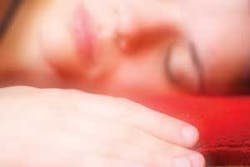Stress and the relaxation response
What is stress? Webster’s New World Dictionary defines stress as “any stimulus, as fear or pain, that disturbs or interferes with the normal physiological equilibrium of an organism; physical, mental, or emotional strain or tension.”
Stress may be bad - “distress” - such as a difficult work environment, divorce, or illness. Stress may also be good - “eustress” - such as the birth of a child, marriage, or the opportunity to present a paper at a large convention. Stress may also be acute or chronic, and it is chronic stress that is debilitating. Stress often occurs as the result of change (such as a new baby to care for) or the need for change (such as dissatisfaction in your work environment or relationship). Change is difficult and frightening, so having ways to respond to stress can prevent chronic stress and even result in a growth experience.
Dr. William Hendrix writes in his article “Dental Stress and Assessment Questionnaire” that three main factors lead to perceived stress among professionals in the workplace today:
- job-related factors
- external or nonjob-related factors
- individual characteristics.
The first two factors are external to the individual while the third represents the individual’s ability to respond to rather than react to stress. Most members of the dental industry identify the pressures of the workplace as their No. 1 source of stress. Workplace pressures most likely include:
- too much work
- too little work
- poor direction at work
- workaholism
- inability to stay atop technical advances
- inability to relax.
Identifying individual stressors is the first step to structuring your environment or external world so you can better control the presence of the stressor or its impact on you.
A feeling of loss of control is a source of stress in itself. In addition, identification of individual stressors allows you to learn how to respond to existing stressors. We can only control our responses to stress, not the external world itself. After structuring your external environment and creating ways to respond to your individual stress triggers, you can develop a more complete action plan for health and well-being. You must control your stress or stress will control you.
An integrated, holistic, and proactive approach to health and wellness can rebalance the physical, emotional, mental, and spiritual aspects of a person.
The holistic approach is any participatory approach to health that takes care of the total person and addresses all aspects of the body, heart, mind, and spirit such as proper nutrition, regular exercise, adequate sleep, sufficient water, and prayer or meditation. Holistic health care includes health professionals such as physicians, dentists, nutritionists, trainers, counselors, and massage therapists. Stress reduction is also a key to maintaining balance and addressing the physical, emotional, mental, and spiritual components of your health.
Stress reduction can be achieved by such techniques as regular exercise, massage, breathing work, yoga or tai chi, acupuncture, Reiki, healing touch, meditation, or prayer - the so-called integrative or complementary therapies.
These are integrative or complementary therapies because they are used in addition to and in concert with standard, physician-driven, Western medical care. Stress reduction is important to maintaining a healthy immune system, balancing your neurological and endocrine systems, and decreasing the effects of aging. We understand at least some of the mechanisms or physiologic basis for why integrative or complementary therapies help maintain good health. In short, these therapies rebalance the immune, neurological, and endocrine systems and result in improved overall health. All of these therapies rebalance body systems by inducing the relaxation response, described below.
The immune system interacts with other body systems and is regulated by proteins called cytokines and hormones. Cytokines are produced in immune, brain, and peripheral body cells (cells other than the brain). Hormones are produced in glands such as the adrenal gland and ovaries. Cytokines can stimulate responses within the central nervous system, or CNS, such as fever and sleep. These cytokines can also affect the endocrine and immune systems in the body. The same cytokines that regulate immune cells regulate brain cells called neurons. This is why we say there is a mind-body connection - because cytokines that regulate the immune and endocrine systems in the body also regulate the brain.
Stress reduction can be achieved through many approaches that collectively may be called the relaxation response, first described by Dr. Herbert Benson and colleagues.1 The relaxation response helps maintain allostasis. Homeostasis means balance and stability. In 2001, Stefano, Benson, and colleagues introduced the term allostasis to describe balance and stability in the face of change.4 This term has more meaning because our physical, emotional, mental, and spiritual bodies must constantly adapt and respond to change. Small amounts of change such as growing new hair, making new skin cells, or even being pregnant, are normal and healthy. Nevertheless, too much change secondary to physical or emotional stress such as from a major illness such as cancer or an emotional event such as a death, results in allostatic loading. The body can respond to allostatic loading for the short term, but if not alleviated, allostatic loading results in illness.4 The relaxation response can relieve allostatic loading and maintain allostasis.
When a person is under stress, levels of specific inflammatory cytokines and hormones are increased in the body and work via neuroendocrine (brain- and gland-mediated) mechanisms to alter the function of immune cells. In the short term, these cytokines and hormones may improve immune function. This is beneficial in the setting of inflammation and infection. The presence of inflammatory cytokines and hormones is regulated by the hypothalamic-pituitary axis, or HPA, via a negative feedback loop. The hypothalamus releases corticotrophin releasing hormone, or CRH, which in turn induces release of adrenocorticotropin hormone, or ACTH, arginine vasopressin, or AVP, and oxytocin from the pituitary. Under normal circumstances, cortisol shuts down release of CRH from the hypothalamus. In the setting of chronic inflammation and stress, the high cortisol levels no longer inhibit secretion of CRH and ACTH. The loss of regulation of the HPA axis results in chronic high levels of cortisol and other glucocorticoids that have been associated with destruction of hippocampal neurons (brain cells in the hippocampus, a part of the brain involved in emotion and memory) leading to problems in learning, memory, and attention, and associated with development of depression.
In addition, the persistence of inflammatory proteins impairs the function of immune cells, contributing to the tendency to become ill while under stress. The relaxation response re-regulates the HPA by shutting down abnormal cortisol production and allows proper functioning of the HPA, immune system, and adrenal gland.
The relaxation response is the opposite of the stress response, also called the fight or flight response. In the fight or flight response, the sympathetic nervous system is activated through pituitary release of AVP, resulting in increased heart rate, blood pressure, respiratory rate, and blood flow to the muscles (a result of increased cardiac output). All of these factors improve survival, such as when someone cuts in front of you at 60 miles an hour.
In contradistinction, the relaxation response activates the parasympathetic nervous system. Initially in the relaxation response, norepinephrine, or NE, is released from peripheral nerve endings called synapses, causing vasoconstriction. Nitric oxide, or NO, is then released and induces vasodilatation by blocking the response of arterial smooth muscle to NE.4 NO inhibits further NE synthesis and release. NO acts as a neurotransmitter by acting at the nerve ending. As a result of the NO-induced vasodilatation, the relaxation response decreases blood pressure, respiratory rate, and oxygen consumption and increases blood flow to the muscles. Blood vessel dilatation also results in warmer hands and feet and increased alertness and focus as a result of increased oxygen delivery to the brain.4
Release of oxytocin from the pituitary decreases sympathetic nervous system and HPA activity (by inhibiting ACTH and possibly CRH release and thereby decreases release of cortisol and glucocorticoids) just as the relaxation response does.2 Oxytocin is the hormone associated with the “tend-and-befriend” response, a response wherein women bond with children and other women resulting in survival or social support. Oxytocin is the hormone associated with uterine contractions at the time of childbirth, and with the milk ejection reflex when nursing. It also appears to have a role in managing chronic stress, at least in part because it reduces the release of glucocorticoids. The effects of oxytocin are enhanced by estrogen, so this hormone is felt to be more potent in women than in men. This hormone is also released and increased in response to hugging, cuddling, and bonding with friends. Stress can be reduced by lunching with friends!
Stress also exacerbates perimenopausal and menopausal symptoms. During menopause, ovarian secretion of estrogen slowly decreases. Estrogen production then increases in the adrenal gland and in body fat so that estrogen is still present, albeit not at premenopausal levels. During times of stress and high cortisol production, the adrenal gland cannot as effectively produce estrogen, resulting in increased menopausal symptoms. By unloading the adrenal gland through use of the relaxation response, menopausal symptoms may also improve. Menopausal symptoms are also improved by the same holistic activities used to address the total health of the entire body, mind, emotion, and spirit, including regular aerobic exercise, drinking plenty of water, getting enough sleep, and as stated, stress reduction. Decreasing or eliminating use of vasoactive substances such as caffeine, alcohol, tobacco, chocolate, and hot, spicy foods will also reduce the specific menopausal symptom of hot flashes.
The relaxation response is not automatic like the stress response, but is elicited by a learned, two-step process.
The first step involves seven to 10 minutes of a chosen repetitive practice. The practice may be repetition of a vocalization such as a word, mantra, sound, or prayer. Alternatively, the repetitive practice may be a breath practice (see following exercise), or a movement practice such as yoga, tai chi, or qigong, or a walking meditation such as walking a labyrinth.
The second step is a passive return to the repetitive vocalization or activity when external thoughts intrude and the mind wanders.
Exercise: the relaxation response
Sit quietly in a comfortable position and loosen any tight clothing around your waist (if possible).
- Close your eyes.
- Deeply relax all your muscles, starting with your feet and moving up to your head. Keep your muscles relaxed.
- Breathe in through your nose and out through your mouth. Become aware of your breathing. Breaths of equal length for about one to two minutes is a good target, followed by breathing for three to seven minutes with the exhalation twice as long as the inhalation, and then returning for a final one to two minutes with the breath of equal length. As you breathe out, repeat a word or brief phrase such as “one” over and over in your mind. Breathe in, breathe out, and think “one.” Breathe in easily and naturally through your nose. Breathe into your stomach. Breathe out through your mouth. Sometimes your breaths will be deeper than others, and that’s OK.
- Continue for at least seven minutes. You may open your eyes to check the time, but do not use an alarm or you will subconsciously prepare for the ringing of the alarm.
- When you finish, sit quietly for several minutes. Keep your eyes closed. Then, after a minute or two, open them. Do not stand up immediately.
Do not become distressed if your mind wanders. It will. Just recognize the thought and quietly bring your mind back to concentrating on breathing and the repeating of your word or phrase. Once you have mastered the skill, you can gain control of yourself and your stress by regularly practicing the relaxation response when a brief break is available. Stress reduction is just seven minutes away. Because of the physiologic changes that occur during the relaxation response, including decreased inflammation and improved immune response, regular activation of the relaxation response may improve or eliminate medical disorders related to stress and can also reduce the rate of cellular aging.
So, address the systems and sources of the stress if you or team members experience stress. These include:
- a lack of desire to go to work
- absenteeism
- tardiness
- poor or altered performance
- difficulty getting along with peers or co-workers
- turnover.
Restructure your environment to minimize stress and gain some control over your life. Identify your stress triggers so you can determine how to respond rather than react to your most common stressors.
The following seven steps are simple ways to restructure and control your environment to take out the negative in your life while maintaining the positive:
Communication
Organization
No! (Learn to say it!)
Time management
Realistic goals
Optimism
Letting go!
Summary
Consider the relaxation response and how it may help you control your environment and respond to your stress.
References
1 Benson H, Beary JF, Carol MP. The relaxation response. Psychiatry, 1974; 37: 37-46.
2 Klein and Corwin, also Brett M, Baxendale S. Motherhood and memory: a review. Psychoneuroendocrinology, 2001;26:339-362.
3 McCann SM, Licinio J, Wong ML, Yu WH, Karanth S, Rettorri V. The nitric oxide hypothesis of aging. Experimental Gerontology 1998; 33:813-826.
4 Stefano GB, Fricchione GL, Slingsby BT, Benson H. The placebo effect and relaxation response: neural processes and their coupling to constitutive nitric oxide. Brain Research Reviews 2001; 35:1-19.
Susan C. Guba, MD
Dr. Guba is a board-certified hematologist and oncologist in private practice in Dallas. She combines standard, Western medical practice with integrative techniques designed to assist patients in healing the body, mind, emotions, and spirit. She was recognized in Dallas and Texas as a “Best Physician” in 2005. Reach her at [email protected].
Cathy Jameson
Jameson is founder, president, and CEO of Jameson Management Inc., an international dental lecture and consulting firm. The Jameson Method of management helps dentists increase productivity and profitability, and control stress. Reach her at [email protected].
STRESS can be the result of a change, such as a new baby to care for, or it can be a need for change, such as dissatisfaction in a relationship.
null
null
A MIND-BODY Connection?
Proteins called cytokines can stimulate responses within the central nervous system such as fever and sleep, affect endocrine and immune systems, and regulate brain cells.
null
Reduce stress by LUNCHING with friends?
Oxytocin is a hormone released during childbirth, breastfeeding, and in response to hugging, cuddling, and bonding with friends. It also reduces the release of glucocorticoids, thereby managing chronic stress.







